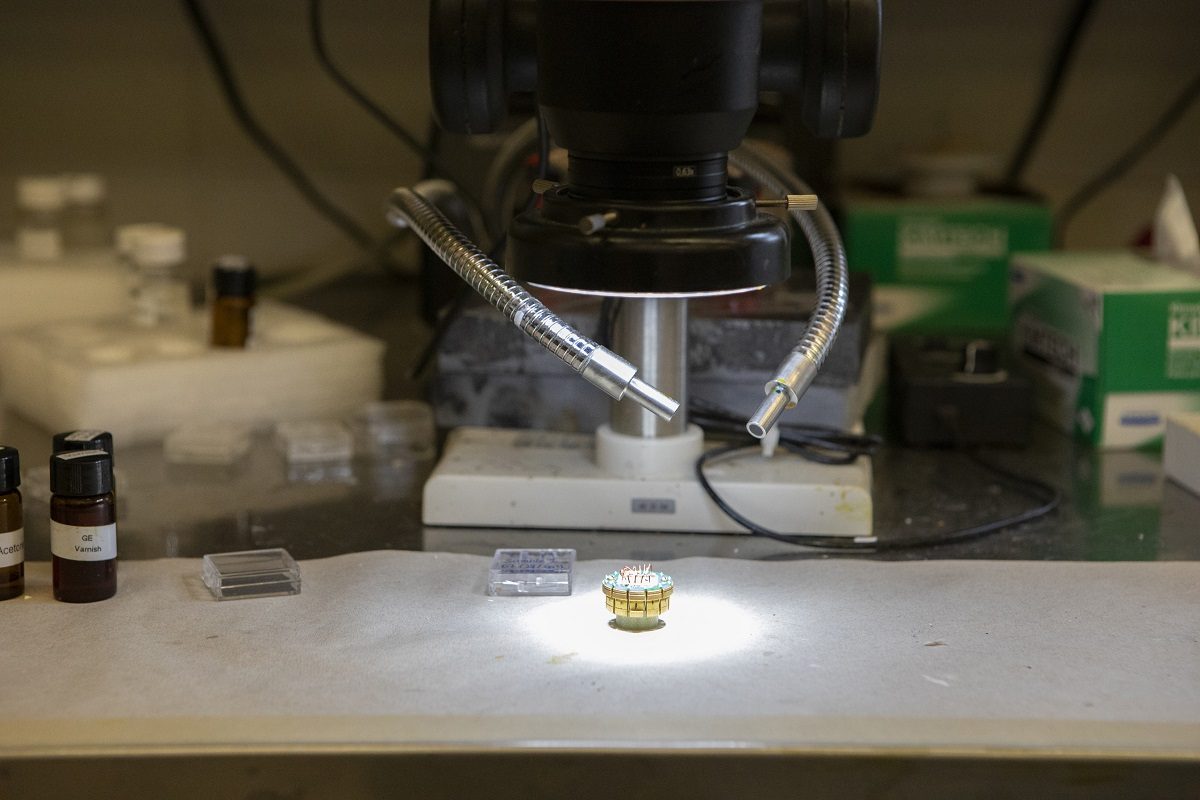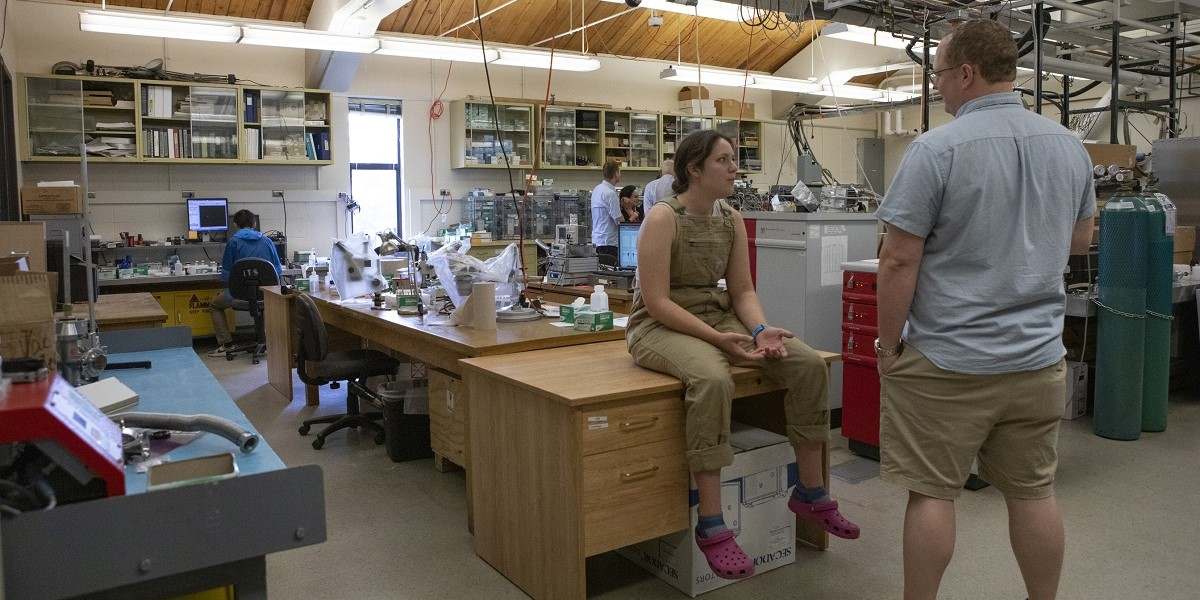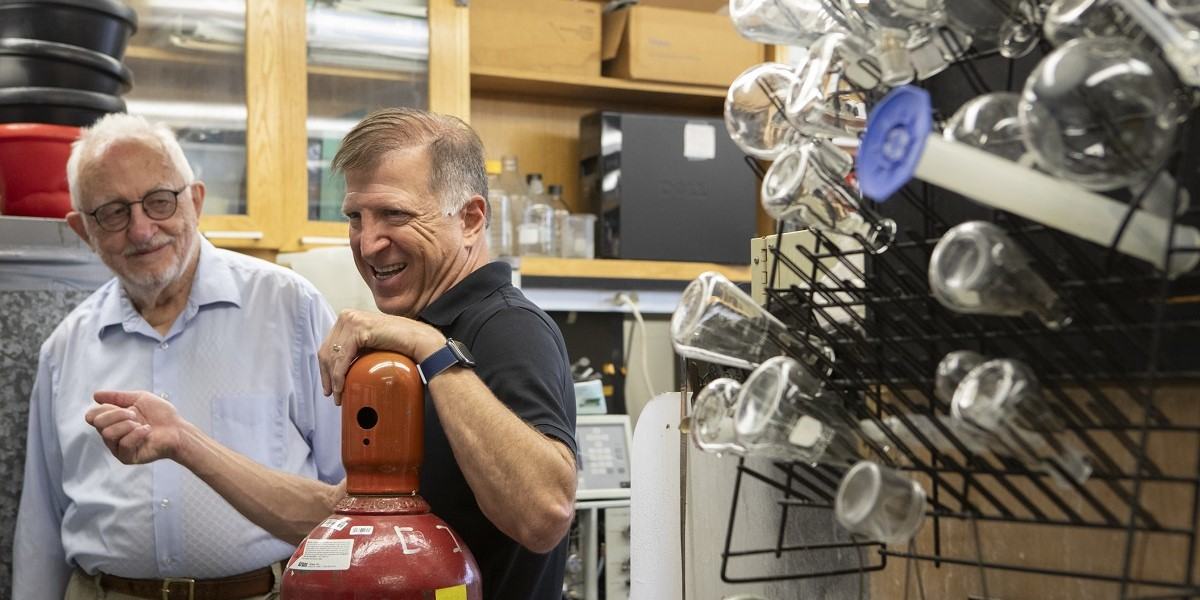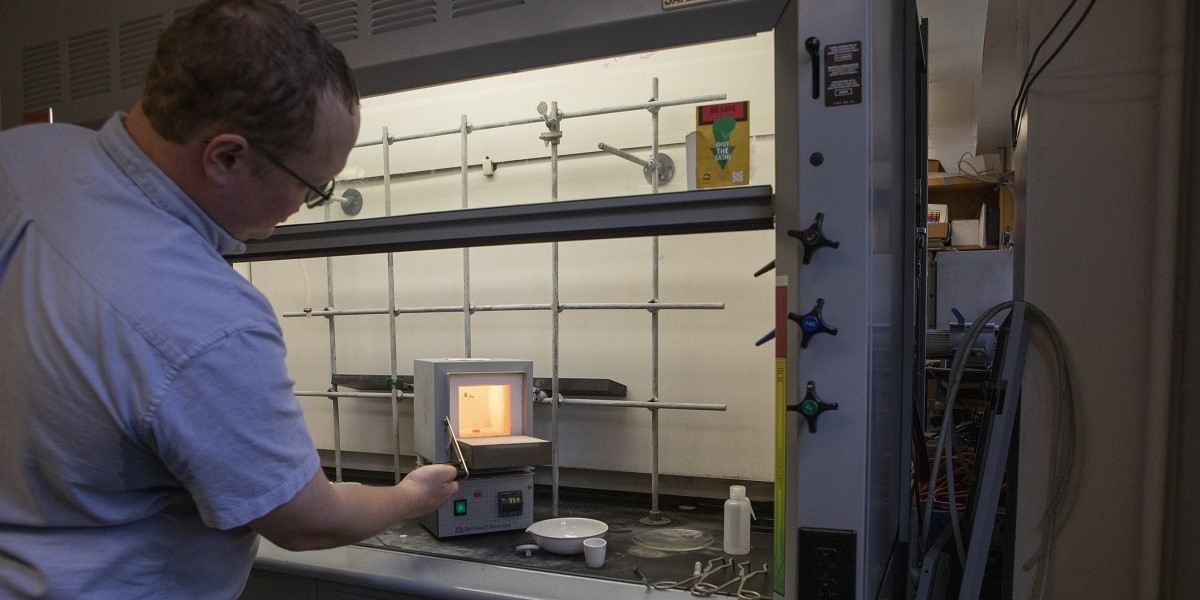
In Gang Cao’s physics lab at the University of Colorado Boulder, scientists can attach probes to samples of possible superconducting materials to test their electrical resistance.
12:56 JST, August 15, 2023
BOULDER, Colo. – Physics graduate student Hope Whitelock popped her head out of the lab at the University of Colorado Boulder on a recent morning to ask a bunch of scientists standing in the hallway for a quick gut check: “Can someone tell me if something is crazy?”
It’s been a few weeks of craziness for physicists and chemists scrambling to make sense of a grandiose claim that popped up in late July: the purported discovery by a team in South Korea of a material that conducts electricity at normal room temperature and air pressure – without losing any energy. The possibility of this long-sought material, called a room-temperature superconductor, quickly went viral, fueled by a video showing a lump of the stuff partially levitating as evidence of its extraordinary properties.
Now the claim is rapidly deflating under scientific study. Over the last few days, papers from academic labs scattered across the globe have built up evidence that LK-99 is not a superconductor and is more likely a type of magnet. (Hyun-Tak Kim, a co-author of one of the discovery papers and a physicist at William & Mary, countered in an email that other research groups’ failure to replicate their results are probably because they lack “know how” in developing the sample the same way.)
The episode has provided the public with an unusual front-row glimpse at a fundamental part of how science works.
Almost as soon as the initial paper appeared online, enthusiasts amplified the excitement among nonexperts, explaining the profound implications if this material, dubbed LK-99, is the real deal: a revolution for the power grid, more powerful medical imaging technologies, magnetically levitating trains – nothing short of a new era for humanity, and a slam dunk Nobel Prize to boot.
Suddenly, people who had never before heard of a superconductor considered the potential ripple effects of the technology. Careful experiments and abstruse calculations in academic labs were catapulted into mainstream interest; Whitelock says high school friends got in touch with her to ask what she thought. Other groups live-streamed their DIY attempts to re-create the material. Some onlookers put money on it, predicting whether it would pan out in volatile online betting markets.
The frenzy over LK-99 meant that scientific thinking evolved on an almost hourly basis, as new findings and videos of varying quality were shared, often via social media.
Philip W. Phillips, a condensed matter theoretical physicist at the University of Illinois at Urbana-Champaign was intrigued by the finding late last week, despite his doubts and questions about the initial papers.
“You don’t want to miss out on what could be the next big thing. That really drives physicists. It drives us all,” Phillips said on Friday.
By Tuesday night, though, the case was closed for him, based on a series of papers that came online in the last day making a convincing case that LK-99 is not a superconductor. “One more nail in the coffin,” Phillips wrote in an email, forwarding yet another paper that adds to the pile of evidence. “So your headline is quite simple.”
Floating rocks
The phenomenon of superconductivity, materials that transmit electricity without resistance, was discovered more than a century ago. The catch has been that the superconductors made so far must operate at extreme conditions – ultracold temperatures or crushing pressures – that are impractical for incorporating into most human technology.
A superconductor that could work in a typical human environment, that wasn’t super toxic or outrageously expensive, could be transformative.
On July 22, South Korean scientists posted two papers to the popular physics site arXiv describing a superconductor that they claimed works at standard temperatures and pressures, made of a modified version of a substance called lead-apatite. They provided a recipe for a material that could be created from cheap, abundant ingredients and a video of a partially floating rock.
Scientists are a skeptical lot – it’s part of the job requirement. There’s no known reason that a room-temperature superconductor couldn’t exist, but decades of experiments have failed to identify one. The field is littered with claims that haven’t panned out for various reasons, and many physicists assumed the new papers would be the latest addition to a long list of apocryphal claims.
But scientists are also, by their nature, open-minded and comfortable dwelling at the edge of the unknown. Part of the reason they plug away in labs for decades is because they hope to discover or understand things that haven’t yet been uncovered.
A legitimate discovery of a room-temperature superconductor would be huge – Phillips said it would carry echoes of the meeting of the American Physical Society in March 1987, the so-called “Woodstock of Physics.” That meeting came a year after a high-temperature superconductor had been identified and then quickly replicated by labs across the world, leading to a Nobel Prize by the fall.
“High temperature” is a bit overstated in this case, as the initial material only worked at minus-400 degrees Fahrenheit, far colder than room temperature. But the announcement kicked off the discovery of a new class of superconductors that scientists are still trying to understand.
Even the possibility that something similarly significant was on the horizon was enough to make many serious scientists drop what they were working on to give it a rigorous test.

Hope Whitelock, a physics graduate student, and Andrew Chomas, a chemistry graduate student, have been working long hours at the University of Colorado Boulder to try to replicate the spectacular superconductor claim.
Baking a batch of LK-99
One such experiment has been underway in the labs of physicists Daniel Dessau and Gang Cao and chemist Josef Michl at the University of Colorado Boulder. That’s where Whitelock recently called her colleagues to come look at the end result of baking chemicals together for two days at 1,700 degrees Fahrenheit.
The experiment had, once again, resulted in a mess of materials and byproducts with various properties – something many groups have observed when following the recipe provided by the South Korean scientists. But when Whitelock broke open the vacuum-sealed tube where she’d tried to bake LK-99, she observed something she hadn’t gotten on past runs – a few intriguing fragments of material that were exhibiting interesting magnetic properties.
There are a number of tests to identify a superconductor, including one called the Meissner effect, in which a material expels its magnetic field as it transitions to become a superconductor. This could lead to the half-levitating rock effect seen in the viral video purporting to show LK-99, but so could other magnetic properties.
“You can kind of see, there are some flakes on here, and they’re tipped up,” Whitelock said, showing through a microscope what tiny flecks of the material look like on top of a magnet. She was quick to point out that this was not evidence of superconductivity.
A short walk away, graduate student Andrew Chomas has been retooling the recipe laid out in the original papers by following his own intuitions as a chemist, to see if they can get a more pure form of LK-99. During a visit to the lab this week, his latest batch was in the oven, a glowing liquid in a crucible made of quartz, heated to a sweltering 1,800 degrees Fahrenheit.
So far, though, all the samples produced in Dessau’s and Michl’s labs have failed basic tests of superconductivity. Dessau said he is keeping his mind open that there may yet be some material of interest in the mixture created by the recipe.
Plus, he said, a room-temperature superconductor “would have incredible implications, so I think it’s worthwhile getting excited about.”

Josef Michl, left, and Daniel Dessau confer in a chemistry lab at the University of Colorado Boulder.

Andrew Chomas, a chemistry graduate student at the University of Colorado Boulder, shows the latest effort to bake a pure sample of the claimed superconductor.
An ongoing quest for superconductors
LK-99 has been a scientific roller coaster, and most experts are glad the public came along for the ride.
Other physicists contend that the original authors should have done more careful work. The paper would have benefited from peer review before making such extravagant claims. But the burst of interest, and increased awareness that scientists are trying to make superconductors, is probably a good thing, they argue.
“The part of it where it shines a light on the subject and its potential utility, and how it’s super fascinating and could eventually lead to a breakthrough technology – that part of it is great,” said Maissam Barkeshli, a theoretical condensed matter physicist at the University of Maryland.
“I guess my conclusion on all this is I’m kind of happy to see it – it’s the first time in a really long time that we’ve seen science not be so political. We’re all just happy about science, and it’s kind of cool,” said Christopher H. Hendon, an associate professor in the department of chemistry and biochemistry at the University of Oregon. He co-authored a paper shared on social media Tuesday afternoon that concludes LK-99 “could more likely be a magnet, rather than an ambient temperature and pressure superconductor.”
If LK-99 is just a magnet, the whimper of deflating interest will be a potent reminder for the general public that science is constantly evolving. Far from a setback, the quest to create and understand superconductors will march forward.
“At the end of the day, science fails more often than not,” Hendon said, adding that “this would be not surprising if [LK-99] went the way of most experiments – that’s how science is.”
"News Services" POPULAR ARTICLE
-

American Playwright Jeremy O. Harris Arrested in Japan on Alleged Drug Smuggling
-

Japan’s Nikkei Stock Average as JGB Yields, Yen Rise on Rate-Hike Bets
-

Japan’s Nikkei Stock Average Licks Wounds after Selloff Sparked by BOJ Hike Bets (UPDATE 1)
-

Japan’s Nikkei Stock Average Buoyed by Stable Yen; SoftBank’s Slide Caps Gains (UPDATE 1)
-

Japanese Bond Yields Zoom, Stocks Slide as Rate Hike Looms
JN ACCESS RANKING
-

Keidanren Chairman Yoshinobu Tsutsui Visits Kashiwazaki-Kariwa Nuclear Power Plant; Inspects New Emergency Safety System
-

Imports of Rare Earths from China Facing Delays, May Be Caused by Deterioration of Japan-China Relations
-

University of Tokyo Professor Discusses Japanese Economic Security in Interview Ahead of Forum
-

Japan Pulls out of Vietnam Nuclear Project, Complicating Hanoi’s Power Plans
-

Govt Aims to Expand NISA Program Lineup, Abolish Age Restriction



















